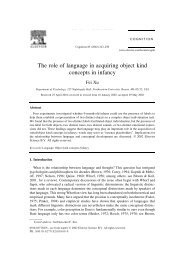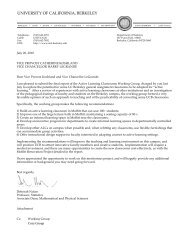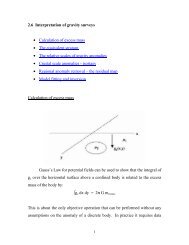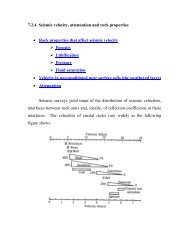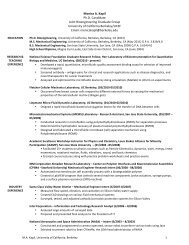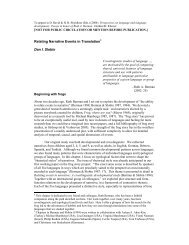Photonic Crystals: Semiconductors of Light - Yablonovitch Research ...
Photonic Crystals: Semiconductors of Light - Yablonovitch Research ...
Photonic Crystals: Semiconductors of Light - Yablonovitch Research ...
You also want an ePaper? Increase the reach of your titles
YUMPU automatically turns print PDFs into web optimized ePapers that Google loves.
my quest for a photonic band-gap material<br />
in a machine shop, carving structures<br />
out <strong>of</strong> dielectric plates with a drill. Only<br />
human imagination limited the crystal design<br />
and structure. Therein lay a problem,<br />
however. Out <strong>of</strong> the innumerable choices<br />
available, which design would produce a<br />
photonic band gap?<br />
In electronic semiconductor crystals,<br />
the band gap arises because electrons behave<br />
partly like a wave, and the waves<br />
scatter <strong>of</strong>f the layers or rows <strong>of</strong> atoms.<br />
Part <strong>of</strong> the wave scatters back the way it<br />
came, and if the wavelength is about the<br />
same as the spacing <strong>of</strong> successive layers,<br />
all the backscattered waves add up coherently.<br />
Consequently, the electron’s<br />
wave is reflected back completely, like<br />
light hitting a mirror. For a full band gap,<br />
this perfect reflection must occur over a<br />
range <strong>of</strong> wavelengths and for waves heading<br />
in any direction through the crystal.<br />
physical intuition as calculations, my coworkers<br />
and I built structure after structure,<br />
searching for the right one. In the<br />
course <strong>of</strong> four years, my loyal machinist,<br />
John Gural, drilled more than 500,000<br />
holes in dielectric (insulating) plates, admittedly<br />
assisted by a numerically controlled<br />
machine. It became unnerving as<br />
we produced failure after failure.<br />
The Surprise <strong>of</strong> Diamond<br />
WE EXPECTED the face-centered cubic<br />
(fcc) structure to be particularly favorable<br />
for making electromagnetic band<br />
gaps. You can build this structure by taking<br />
a checkerboard and placing a black<br />
cube on each white square and a white<br />
one on each black square. On the second<br />
layer, continue placing black cubes on<br />
white and vice versa, and so on up. The<br />
black cubes (and separately also the<br />
white ones) form an fcc lattice.<br />
Unlike lattices <strong>of</strong> atoms, photonic crystals have<br />
structural possibilities limited only by the human imagination.<br />
Any shape can be sculpted at the lattice sites.<br />
For an electromagnetic band gap, I<br />
knew one could not simply emulate a silicon<br />
crystal. For light, the scattering is<br />
caused by changes <strong>of</strong> refractive index (for<br />
instance, between air and glass), and an<br />
interaction directly analogous to electrons<br />
and silicon atoms would require a<br />
material with an extraordinary refractive<br />
index.<br />
Nor could one simply deduce a structure<br />
from theory: the band gap depends<br />
on how the waves interact with many<br />
hundreds <strong>of</strong> holes, a very complicated<br />
process. Theorists had developed computer<br />
models for doing the calculations<br />
for semiconductors, but these programs<br />
could not be used for photons. First, the<br />
equations <strong>of</strong> motion are different—Schrödinger’s<br />
equation governs electrons, but<br />
Maxwell’s equations describe the behavior<br />
<strong>of</strong> light. Second, with photons one<br />
cannot safely neglect polarization the way<br />
one can with electrons. Consequently, I<br />
had no way to determine whether a proposed<br />
structure would have a photonic<br />
band gap. And so, guided as much by<br />
That structure still leaves an infinite<br />
variety <strong>of</strong> choices because you can substitute<br />
any other geometric shape for the<br />
black cubes, which alters how the light<br />
waves will be refracted and reflected. After<br />
two years, we arrived at something<br />
that seemed to work: an fcc structure in<br />
which each black cube was replaced by a<br />
spherical void in the material. I published<br />
this result, but I was mistaken.<br />
By now the theorists had started to<br />
catch up, and a few <strong>of</strong> them had retooled<br />
their band-structure computer programs<br />
to work with light. Several theory groups,<br />
including those led by K. Ming Leung <strong>of</strong><br />
Polytechnic University and Kai Ming Ho<br />
<strong>of</strong> Iowa State University, began making<br />
those dreaded phone calls. My longsought<br />
fcc structure had only a pseudogap:<br />
a forbidden “band” having zero<br />
width, meaning that just one exact wavelength<br />
<strong>of</strong> light was forbidden. After our<br />
years <strong>of</strong> effort, it appeared that nature<br />
might not permit a photonic band gap to<br />
exist at all. Perhaps it required a substance<br />
with a refractive index far beyond<br />
that <strong>of</strong> any existing transparent material.<br />
Within weeks, however, the Iowa<br />
State group found that the diamond<br />
structure, the tetrahedral crystal geometry<br />
associated with the precious jewel,<br />
would produce a band gap. The form<br />
that gives the widest band gap consists <strong>of</strong><br />
dielectric rods in the positions <strong>of</strong> the<br />
chemical bonds between carbon atoms,<br />
with the atoms shrunk to geometric<br />
points. Diamond itself is not a photonic<br />
band-gap material, as far as we know.<br />
Earlier in this piece I said that when we<br />
began our research, we knew we could<br />
not simply emulate the silicon crystal<br />
structure to produce a photonic band<br />
gap. How wrong we were: silicon’s crystal<br />
structure is precisely that <strong>of</strong> diamond.<br />
That the tetrahedral structure is the<br />
best for making a photonic band gap is<br />
startling and pr<strong>of</strong>ound. Before the advent<br />
<strong>of</strong> photonic crystals, the diamond configuration<br />
was merely another mineral<br />
structure, arising out <strong>of</strong> a complex interplay<br />
<strong>of</strong> atoms, chemical bonds and energy<br />
minimization under suitable conditions<br />
<strong>of</strong> temperature and pressure. Its utility<br />
for forming a photonic band gap,<br />
which emerges entirely and solely from<br />
Maxwell’s equations (the laws <strong>of</strong> electricity,<br />
magnetism and light), shows that<br />
the diamond configuration also has fundamental<br />
significance in relation to electromagnetism<br />
and the geometry <strong>of</strong> threedimensional<br />
space.<br />
Diamond’s tetrahedral structure takes<br />
on many different appearances according<br />
to what shape is placed in each lattice site<br />
and from which angle the crystal is<br />
viewed. The box on the opposite page includes<br />
two very dissimilar photonic crystals<br />
that are based on the diamond structure.<br />
My group made the first successful<br />
photonic band-gap crystal (this time for<br />
real) in 1991 using a variant <strong>of</strong> the diamond<br />
structure now called yablonovite.<br />
Nature is kind after all: a band gap occurs<br />
in the diamond structure for a refractive<br />
50 SCIENTIFIC AMERICAN DECEMBER 2001<br />
Copyright 2001 Scientific American, Inc.


